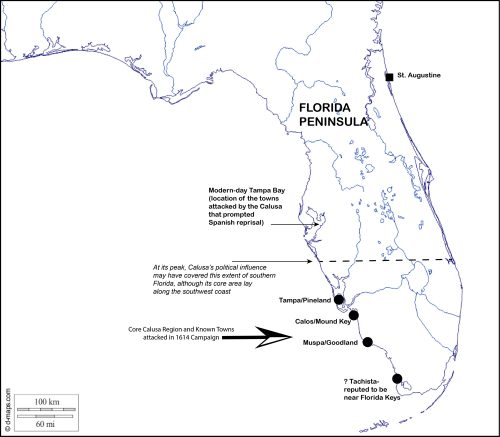Within North America’s rich Native American history, the Calusa of southwest Florida are remarkable in many ways, including their cultural resilience in the face of Spanish colonization efforts in the 16th century. Beginning in December 2020, a new project will document and preserve those efforts.

Prior to 1614, with the establishment of St. Augustine as the Spanish capital of La Florida, Spaniards used missionary efforts and military force to influence and control Native American people across northern Florida. Such efforts were not as successful in the southern portions of Florida, particularly among the Calusa. Relying on a large population size, mastery of coastal estuarine waterways, and an extensive socio-political network, the Calusa rebuffed Spanish incursions through the late 16th and early 17th centuries. In an effort to overcome them, the Spanish established alliances with Native groups around modern- day Tampa Bay known to have unfriendly relations with the Calusa. And, in March of 1614, the Spaniards launched two water-borne attacks against the Calusa in response to an attack the Calusa had waged on two Spanish-allied Native American towns in Tampa Bay earlier that year (Figure 1).
The 1614 Spanish campaign was the first large-scale battle between Europeans and Native Americans during the colonial era of eastern North America. Four towns were attacked; Calos (Mound Key site), Tampa (Pineland site), Muspa (Goodland site), and Tachista (location to be confirmed). Funded by the National Park Service’s American Battlefield Protection Program and with the support of the Randell Research Center, the new project will identify and document the four battle sites and raise public awareness of this era of Calusa history.
Archaeologists Charlie Cobb, Gifford Waters, and Michelle LeFebvre from the Florida Museum will lead the project, assisted by archaeologist and historian John Worth from the University of West Florida, and archaeologists and artifact conservation specialists Steve Smith, James Legg, and Chester DePratter from the South Carolina Institute of Archaeology and Anthropology.
The first year of work will include the translation of historic Spanish documents, fieldwork excursions, artifact conservation, public outreach, and consultation with the Seminole Tribe of Florida’s Heritage and Environmental Resources Office. The team will locate and translate select components of over 40,000 pages of colonial Spanish documents and accounts of Spanish Florida and Native American interactions. Fieldwork will include professional systematic metal detection for the identification of colonial era artifacts and strategic shovel testing. Results will be shared through free public lectures, newsletter updates, and other opportunities. If the project succeeds, it will add an important chapter to the fascinating history of the Calusa people.